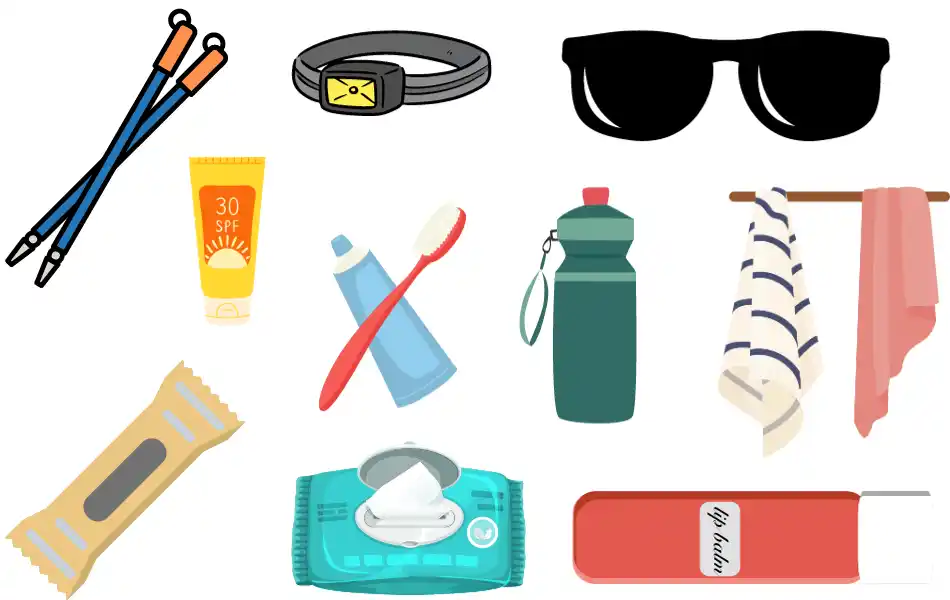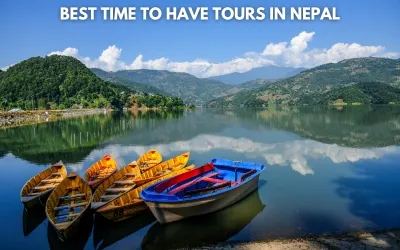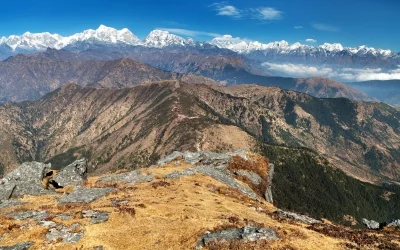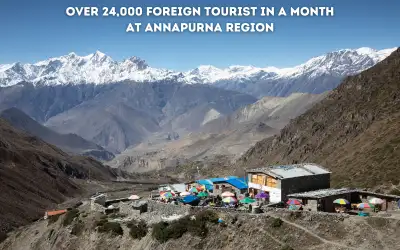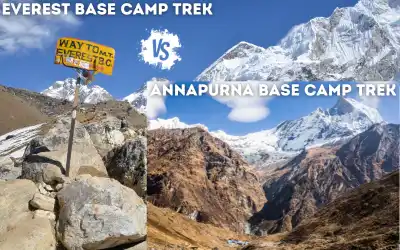Preparation for Annapurna Circuit Trek | Best Tips
November 8, 2023Preparation for Annapurna Circuit Trek
- Preparation for Annapurna Circuit Trek
- Annapurna Circuit Trek Overview
- Preparation for Annapurna Circuit Trek: Required Permits
- Which is the best itinerary for the Annapurna Circuit Trek?
- Preparation for Annapurna Circuit Trek | What Are the Packing Lists?
- What is the best time for the Annapurna Circuit Trek?
- How do I manage food and accommodations?
- Preparation for Annapurna Circuit Trek | Physical Fitness and Training
- Preparation for Annapurna Circuit Trek | Safety and Health Tips
- Conclusion: Is it necessary to prepare for the Annapurna Circuit Trek?
The Annapurna Circuit Trek, often described as one of the world’s most breathtaking and rewarding adventures, isn’t just a physical journey—it’s a journey of the spirit. Nestled in the heart of the Himalayas, this iconic trek offers much more than just stunning mountain vistas and challenging trails; it’s a profound experience that touches the soul.
Imagine standing amidst towering peaks where the air is crisp and the prayer flags flutter in the Himalayan breeze. The Annapurna Circuit isn’t just about reaching your destination; it’s about the transformative journey you will embark on, both physically and mentally.
Are you planning for the trek to Annapurna Circuit? If you are, then here are the best tips for the preparation of the Annapurna Circuit Trek. This blog will cover all the necessary preparations you need to make before embarking on the journey to Annapurna Circuit.
As the trek weaves through lush forests, serene villages, and high-altitude gloominess, you will have an experience of profound exploration of Nepal’s natural beauty, rich culture, and indomitable human spirit.
Let’s get deeper into the overview of the Annapurna Circuit Trek and learn more about the distance, duration, and other basic information about the trek.
Annapurna Circuit Trek Overview
Annapurna Circuit Trek is a 13-day trek starting from the beautiful city of Kathmandu. The trekking days can be minimized by starting from Pokhara too. As the trek is easily accessible through different trekking agencies, you don’t have to invest more time in the basic preparations.
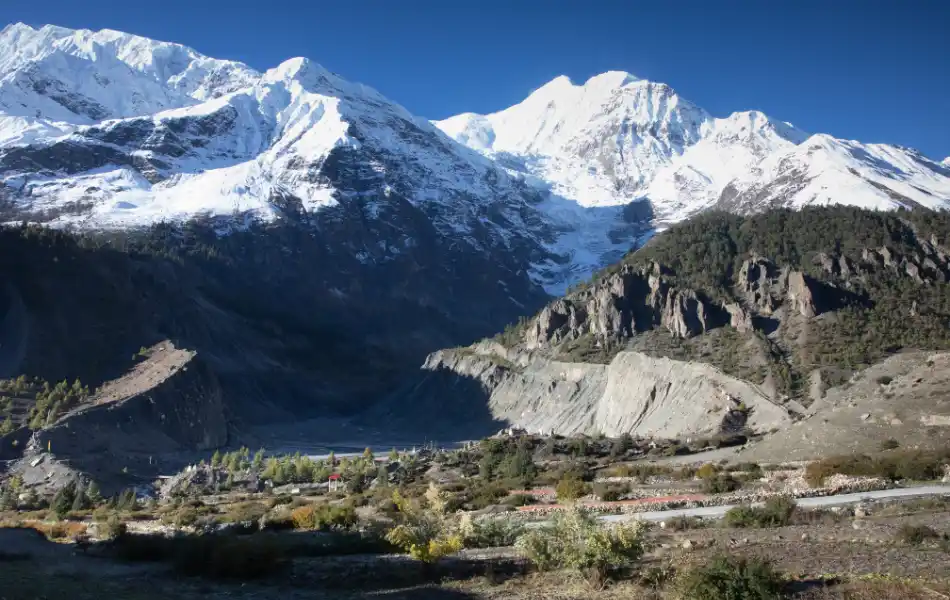
But if you are trekking on your own by hiring a guide or porter, then you must know these best tips for the preparation of the Annapurna Circuit Trek.
As this trek is moderate in difficulty, it can be challenging if the preparation for the Annapurna Base Camp Trek is incomplete. This 13-day Annapurna Circuit Trek takes you through stunning Himalayan landscapes and offers you long-lasting memories of the Himalayan views.
Annapurna Circuit Trek Highlights
- Majestic views of Annapurna Massif, including Annapurna I, and other peaks like Dhaulagiri and Manaslu
- Thorong La Pass, a high mountain pass at an elevation of 5,416 meters, holds one of the most challenging parts of the trek
- Muktinath Temple, a sacred Hindu, and Buddhist pilgrimage site
- Visiting the remote and traditional villages of the Annapurna Region
- Kali Gandaki River, the deepest river gorge in the world
- Experience the rich culture of the local Gurung and Thakali communities
Preparation for Annapurna Circuit Trek: Required Permits
Permits are important to obtain on the Annapurna Circuit Trek. For trekking in the Annapurna Region, trekkers have to get the TIMS (Trekkers’ Information Management System) card and the ACAP (Annapurna Conservation Area Permit).
A TIMS card is necessary for every trekker who wants to trek in Nepal. The main reason to implement this card is to gather information about the trekkers who want to trek in Nepal for safety purposes.
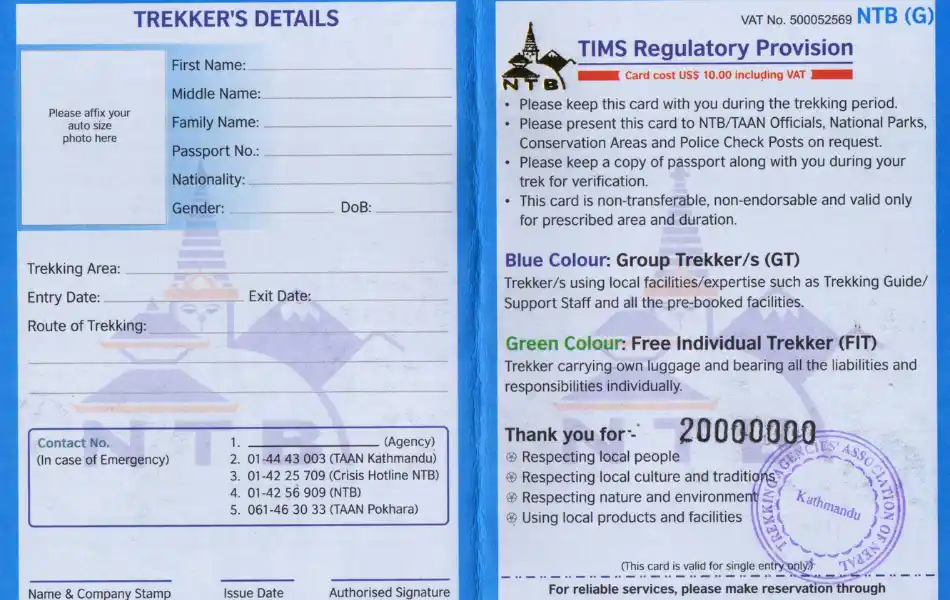
However, as per the revised TIMS provision effective March 31, 2023, trekkers can’t solo trek in Nepal. So, you have to get a licensed trekking guide and carry an agency-issued TIMS Card.
The cost of the TIMS Card for foreigners other than the SAARC countries is NPR 2,000 and for the SAARC countries, it is NPR 1,000.
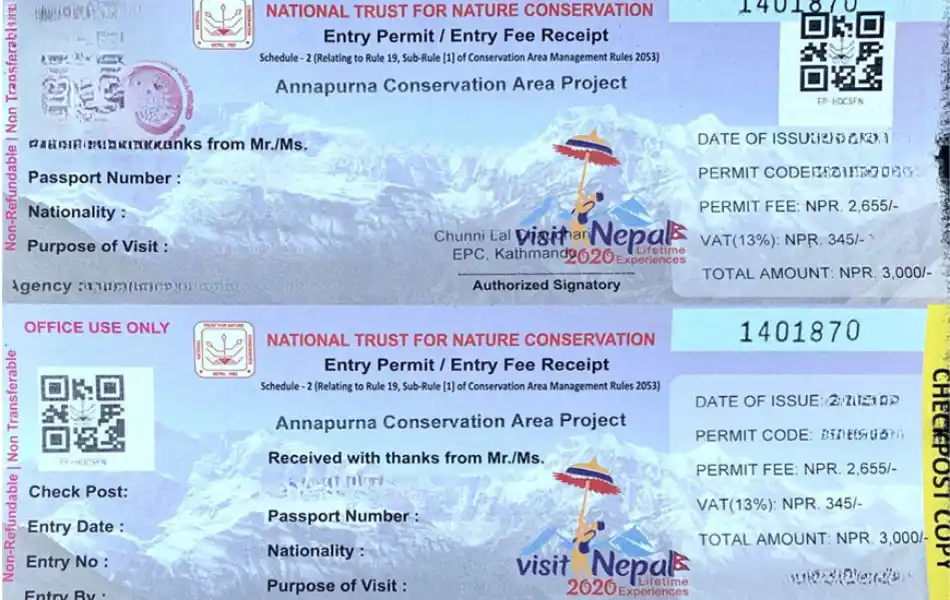
However, for the Annapurna Conservation Area Permit, you can get it from the Nepal Tourism Board of Kathmandu or Pokhara. It costs NPR 3,000 (USD 25) for foreigners, NPR 1,000 for SAARC nationals, and NPR 100 for Nepali citizens.
It is necessary to obtain both permits if you are planning to make the trek to Annapurna Circuit. By the way, do you need an agency where you can have a hassle-free booking that manages the necessary permits and every basic requirement? You can book the Annapurna Circuit Trek package with us anytime.
Which is the best itinerary for the Annapurna Circuit Trek?
Annapurna Circuit Trek is a challenging trek in the Annapurna region, so planning the appropriate and better itinerary is important to minimize the difficulty during the trek. Here is an overview of the Annapurna Circuit Trek. For a detailed itinerary of the Annapurna Circuit Trek, click here.
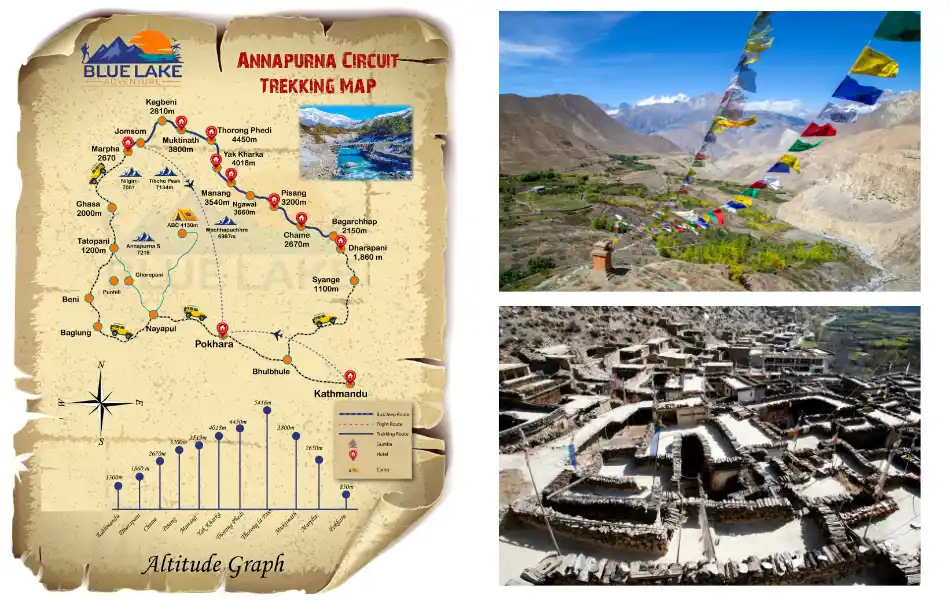
Day 01: Arrival Day | Get to the Hotel
Trip facts: Max altitude – 1,400m (Kathmandu) | Transportation duration – 20/25 minutes (Private Car) | Accommodation – Hotel
Day 02: Early morning Dharapani drive from Kathmandu
Trip facts: Max altitude – 1,860m (Dharapani) | Transportation duration – 7/8 hours | Accommodation – Teahouse/Lodge
Day 03: First Trek Day | Dharapani to Chame
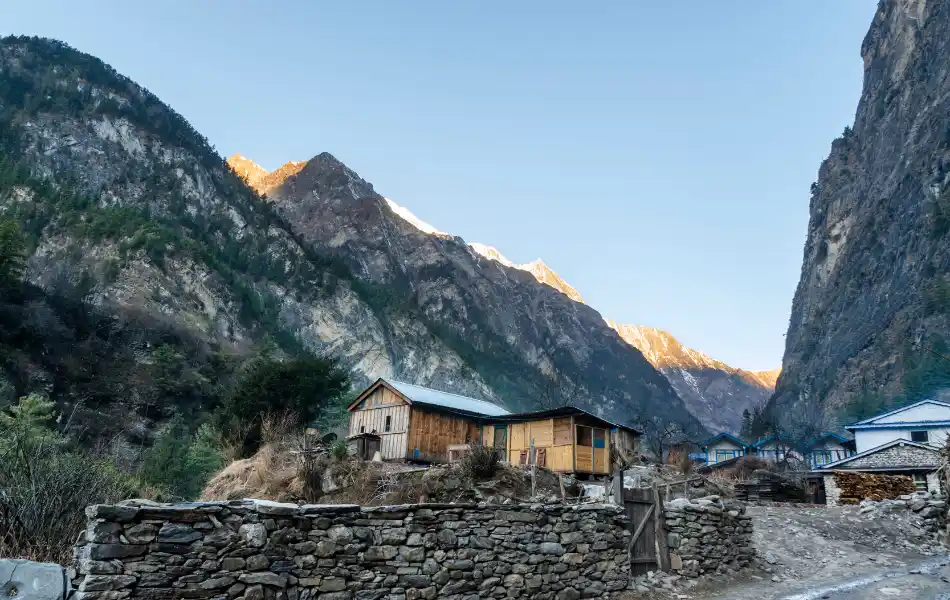
Trip facts: Max altitude – 2,650m (Chame) | Trekking duration – 6/7 hours | Accommodation – Teahouse
Day 04: Trek to Upper Pisang from Chame | Altitude Gain
Trip facts: Max altitude – 3,115m (Upper Pisang) | Trekking duration – 5/6 hours | Accommodation – Teahouse
Day 05: Trek to Manang from Upper Pisang
Trip facts: Max altitude – 3,519m (Manang) | Trekking duration – 5/6 hours | Accommodation – Teahouse
Day 06: Important Day | Acclimatization at Lower Manang
Trip facts: Max altitude – 3,519m | Accommodation – Teahouse
Day 07: Trek to Yak Kharka from Lower Manang
Trip facts: Max altitude – 4,018 (Yak Kharka) | Trekking duration – 6/7 hours | Accommodation – Teahouse
Day 08: Trek to Thorong Phedi from Yak Kharka
Trip facts: Max altitude – 4,450m (Thorong Phedi) | Trekking duration – 6/7 hours | accommodation – Teahouse
Day 09: Challenging Trek | Trek to Muktinath from Thorong Phedi via Thorong La-Pass
Trip facts: Max altitude – Muktinath (5,416m) | Trekking duration – 7/8 hours | Accommodation – Teahouse
Day 10: Trek to Marpha from Muktinath
Trip facts: Max altitude – 2,650m (Marpha) | Trekking duration – 5/6 hours | Accommodation – Lodge
Day 11: Drive to Pokhara from Marpha | Private Jeep
Trip facts: Max altitude – 822m (Pokhara) | Transportation duration – 7/8 hours (Private jeep) | Accommodation – Hotel
Day 12: Drive to Kathmandu from Pokhara | Alternative Flight
Trip facts: Max altitude – 1,400m (Kathmandu) | Transportation duration – 7/8 hours (Tourist bus) or 30/40 minutes (Flight) | Accommodation – Hotel
Day 13: Departure Day
Preparation for Annapurna Circuit Trek | What Are the Packing Lists?
For better preparation, you need to have a proper set of gear and a packing list. Here are some of the items on the packing list you can consider getting for the Annapurna Circuit Trek.
Clothing
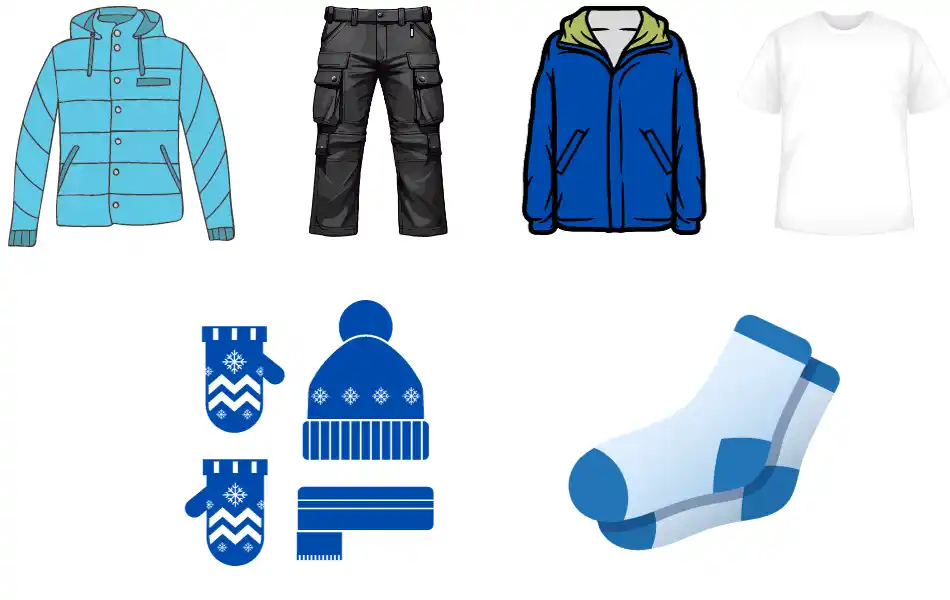
- Moisture-wicking base layers (top and bottom)
- Insulating mid-layers (fleece or down jacket)
- Lightweight, waterproof, and breathable jacket and pants
- Quick-dry trekking pants
- Long-sleeve and short-sleeve trekking shirts
- Warm hat and gloves
- Sun hat or cap
- Buff or neck gaiter
- Trekking socks
Footwear
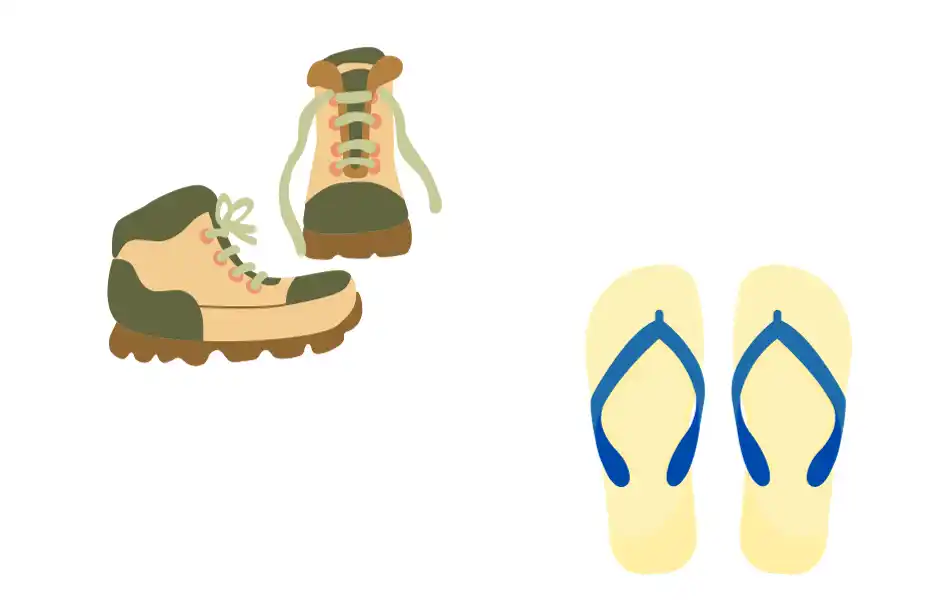
- Sturdy, waterproof trekking boots
- Camp shoes
Backpack
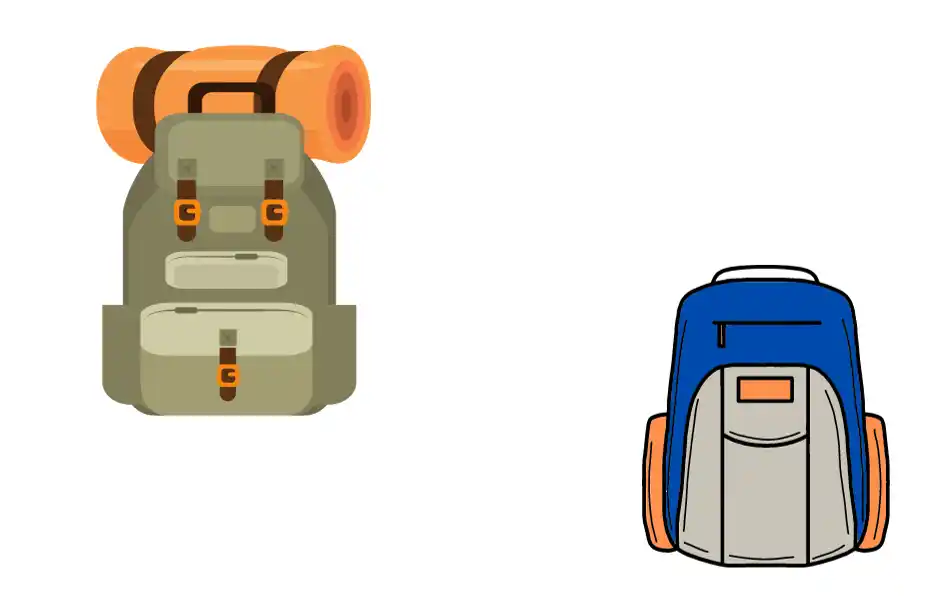
- Trekking backpack with rain cover (30–50 liters)
- Daypack (small, for daily essentials)
Sleeping gear
- Four-season sleeping bag (0 degrees F or lower comfort rating)
- Lightweight sleeping pad or inflatable mattress
Trekking Accessories
- Trekking poles (adjustable and collapsible)
- Headlamp or flashlight with extra batteries
- Sunglasses with UV protection
- Water purification method (water filter or purification tablets)
- Reusable water bottle or hydration system
- Snacks and energy bars
- Travel towel (quick drying)
Personal Hygiene
- Hand sanitizer
- Toothbrush and toothpaste
- Biodegradable soap
- Wet wipes
- Personal medications and first aid kit
- Insect repellent
- Sunscreen (high SPF)
- Lipbalm
Documents and Money
- Passport and visa (with photocopies)
- Necessary permits (TIMS and ACAP)
- Travel Insurance
- Local currency (Nepali rupees with changes)
Electronics
- Camera with extra batteries
- Portable charger and power bank
- Adapter and converter (Type C and Type A)
- Smartphone with maps and trekking apps (if possible)
What is the best time for the Annapurna Circuit Trek?
Trekking at the best time is one of the most important factors to consider during the preparation of the Annapurna Circuit Trek. Autumn and spring seasons are the best times for trekking to Annapurna Circuit. Although trekking in winter is possible too, it is not the best time.
Spring (March to May) is the best time for the Annapurna Circuit Trek, as it offers the best weather and temperature ideal for hiking in the Annapurna Region. One of the major highlights of this season is the blooming of the rhododendrons and other wildflowers that make the trail beautiful with their vibrant colors.
During this time, the skies are clear so you can get stunning views of the Annapurna massif without any disturbance. Moreover, during this time, the trails are well-maintained, the views of the traditional village are amazing, and the accommodation options are widely available.
In addition, with no disturbance from the rainfall, you can enjoy the trekking experience on the Annapurna Circuit at its peak.
Autumn (September to November) is another peak season for trekking on the Annapurna Circuit Trek. This season has the same features as the spring but it is less crowded than the spring. So, most of the trekkers who want to avoid the crowds on trails and teahouses prefer trekking during this season.
As with spring, the highlights of this season are its stable and sunny weather, warm day temperatures with chilly nights at higher altitudes, and absolutely stunning views of the snow-capped Annapurna massif alongside the Dhaulagiri and Manaslu.
How do I manage food and accommodations?
As with other basic things, it is equally important to manage the food and accommodation options during the Annapurna Circuit Trek. While there is a wide variety of food and accommodations available, the choice is yours to make the trek budget-friendly or luxurious.
For accommodation, you have the option of both teahouses and lodges. Teahouses are less expensive with basic facilities like twin-sharing bedrooms, sharing bathrooms with squat toilets, comfortable beds, and blankets.
They do offer additional facilities like Wi-Fi, hot water, and charging, but at an additional cost.
While lodges are quite expensive at higher altitudes, they provide the best facilities, like private bedrooms with attached bathrooms, TVs, hot showers, charging options, and comfortable beds with warm bedsheets and blankets.
If you are looking for more of a budget trek, teahouse accommodation is best, as they include the basic facilities but at a cheaper price.
During the Annapurna Circuit Trek, you will have a variety of food options available at the teahouses and lodges. One of the common foods available is Nepali Dal Bhat, which is basically rice, lentils, vegetables, and pickles. It is one of the most nutritious foods available during the trek. You must definitely try it.
Other than that, you can have different breakfast courses, including omelets and porridge, tea/coffee, bread, etc. The cost of the food might get expensive as you gain altitude.
Whereas for lunch and dinner, you can have momos, bread, noodle soups, and dal bhat. Make sure you eat nutritious food during the trek and eat as much as you can before starting the trek.
While trekking, you can carry some light snacks like chocolate bars, energy bars, etc. to have when you need energy or are hungry. Also, it is better to carry a thermos for hot water to drink.
Preparation for Annapurna Circuit Trek | Physical Fitness and Training
As the Annapurna Circuit Trek is a challenging trek, it is important to have better physical fitness. You need to be in good shape so that you can carry on the trek with less difficulty. The trek includes trekking for an average of 5/6 hours a day, so you must be physically fit to walk for hours at a normal pace.
Here are some tips to help you get in shape and acclimatize to the higher elevations:
- Cardiovascular fitness: Engage in aerobic exercises such as running, cycling, and swimming to improve your cardiovascular endurance.
- Strength training: Build muscle strength to carry your backpack and handle steep ascents and descents. Focus on leg muscles (quads, hamstrings, and calves) and core strength.
- Hiking and Walking: Practice hiking with a loaded backpack to get used to the weight.
Stair climbing: Stair climbing or hill training is an effective way to mimic the uphill and downhill sections of the trek. - Flexibility and stretching: Include stretching exercises to improve flexibility and reduce the risk of muscle strains.
- Breathing exercises: Practice deep breathing exercises to improve lung capacity and oxygen utilization.
- Hydration and Nutrition: Stay well-hydrated and maintain a balanced diet rich in carbohydrates, proteins, and healthy fats.
- Stay active at altitude: During acclimatization days, take short hikes or walks to higher elevations and return to a lower altitude to sleep.
Preparation for Annapurna Circuit Trek | Safety and Health Tips
During the Annapurna Circuit Trek, it is important to follow the safety and health tips in order to make the trek less difficult.
Some of the safety precautions and health tips during the Annapurna Circuit Trek are:
- Altitude Acclimatization: Follow a gradual ascent plan with acclimatization days to avoid altitude sickness. Also, be prepared to descend if you experience severe symptoms like headaches, nausea, or shortness of breath.
- Trekking permits: Make sure you carry the necessary permits and respect the local regulations and checkpoints.
- Weather information: Stay informed about weather conditions, especially during the monsoon and winter seasons.
- Local guides: Hire local guides who are well-known about the Annapurna Circuit Trek routes. Make sure they are government-license holders Also, local guides are knowledgeable about the terrain and culture and can provide crucial support during the trek.
- Carry a first aid kit: Bring a basic first aid kit with essential supplies like bandages, antiseptics, pain relievers, and any other personal medications.
- Food and water safety: Consume cooked and hot meals from better teahouses and lodges. Also, use water filtration tablets for the water or boil the water before drinking if possible.
- Travel Insurance: Purchase comprehensive travel insurance that covers trekking, medical emergencies, and evacuation.
- Sun protection: Use high-SPF sunscreen and wear sunglasses, a hat, and lip balm with sunblock to protect against UV radiation.
- Insect Protection: Use insect repellent to guard against mosquitoes, especially in lower-altitude regions.
- Get proper rest and listen to your body: It is important to get better rest before and after the trek. Always listen to your body instead of matching the pace of the other trekkers.
- Sanitation and Hygiene: Practice good hygiene, use hand sanitizer, and be mindful of cleanliness in lodges and teahouses.
Conclusion: Is it necessary to prepare for the Annapurna Circuit Trek?
Yes, it is absolutely important for the preparation of the Annapurna Circuit Trek, as it is one of the most challenging treks in the Annapurna Region. In order to make the trek more comfortable and easier, it is important to choose the right time for trekking, pack the right gear, and, last but not least, follow the safety and health tips.
In addition, it is important to be physically fit for the trek. Whether you are a beginner or someone with trekking experience, you need to be in good shape to do this trek.
Follow the tips we provided in this blog to enjoy the Annapurna Circuit Trek even better. Also, if there are any queries about preparation for the Annapurna Circuit Trek, then reach out to us at info@travelagencyinnepal.com or contact us through the Contact Us page.
Also, if you are good to go for the trek but don’t want to involve yourself in preparations like hiring a guide, booking accommodations, getting permits, and managing food, then you can do the Annapurna Circuit Trek for 13 days with us. To get the package, contact us so that we can plan everything for you.
FAQs on Preparation for Annapurna Circuit Trek
What is the best time to trek the Annapurna Circuit?
The best time to trek the Annapurna Circuit is during the spring (March to May) and autumn (September to November), when the weather is relatively stable, offering clear skies and moderate temperatures.
Do I need permits to trek the Annapurna Circuit?
Yes, you are required to obtain the TIMS card and Annapurna Conservation Area Permit for the Annapruna Circuit Trek. You can get them from Kathamndu and Pokhara, and you should carry them at all times during the trek.
How long does the Annapurna Circuit Trek take?
The Annapurna Circuit Trej typically takes 12–21 days to complete, depending on your pace and fitness level. The average distance covered each day is around 10–11 kilometers.
What is the level of difficulty of the Annapurna Circuit Trek?
The Annapurna Circuit Trek is considered a challenging trek as it involves high altitudes, steep ascents and descents, and varied terrain. However, it is also one of the most rewarding treks in Nepal, offering stunning scenery and a unique cultural experience.
How much water do you need to carry on the Annapurna Circuit?
The amount of water you need to carry on the Annapurna Circuit trek depends on a variety of factors, including your fitness level, the time of year, and the weather conditions. However, in general, you should aim to carry at least 3 liters of water per day.
Is the Annapurna Circuit Trek for beginners?
Although the Annapurna Circuit Trek is suitable for beginners as well as first-time hikers, it is not recommended for the trek until you are physically and mentally fit. If you are a beginner, then you need to follow the trekking tips and the safety measures before embarking on the trek.


